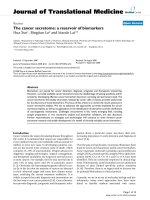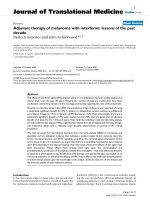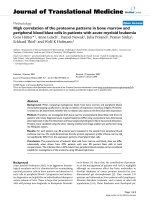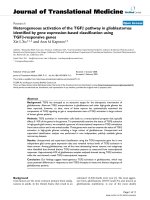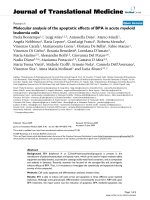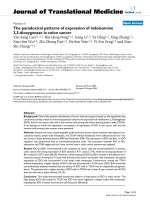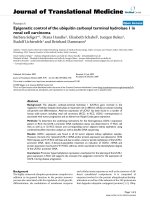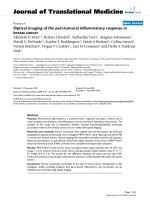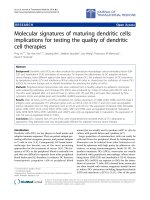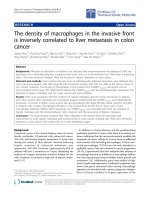báo cáo hóa học: " The effect of consequent exposure of stress and dermal application of low doses of chlorpyrifos on the expression of glial fibrillary acidic protein in the hippocampus of adult mice" pptx
Bạn đang xem bản rút gọn của tài liệu. Xem và tải ngay bản đầy đủ của tài liệu tại đây (540.06 KB, 9 trang )
RESEARCH Open Access
The effect of consequent exposure of stress and
dermal application of low doses of chlorpyrifos
on the expression of glial fibrillary acidic protein
in the hippocampus of adult mice
Kian Loong Lim
1†
, Annie Tay
2†
, Vishna Devi Nadarajah
3†
, Nilesh Kumar Mitra
3*
Abstract
Background: Chlorpyrifos (CPF), a commonly used pesticide worldwide, has been reported to produce
neurobehavioural changes. Dermal exposure to CPF is common in industries and agriculture. This study estimates
changes in glial fibrillary acidic protein (GFAP) expression in hippocampal regions and correlates with
histomorphometry of neurons and serum cholinesterase levels following dermal exposure to low doses of CPF
with or without swim stress.
Methods: Male albino mice were separated into control, stress control and four treatment groups (n = 6). CPF was
applied dermally over the tails under occlusive bandage (6 hours/day) at doses of 1/10th (CPF 0.1) and 1/5th
dermal LD
50
(CPF 0.2) for seven days. Consequent treatment of swim stress fol lowed by CPF was also applied.
Serum cholinesterase levels were estimated using spectroflurometric methods. Paraffin sections of the left
hippocampal regions were stained with 0.2% thionin followed by the counting of neuronal density. Right
hippocampal sections were treated with Dako Envision GFAP antibodies.
Results: CPF application in 1/10th LD
50
did not produce significant changes in serum cholinesterase levels and
neuronal density, but increased GFAP expression significantly (p < 0.001). Swim stress with CPF 0.1 group did not
show increase in astrocytic density compared to CPF 0.1 alone but decreased neuronal density.
Conclusions: Findings suggest GFAP expression is upregulated with dermal exposure to low dose of CPF. Stress
combined with sub-toxic dermal CPF exposure can produce neurotoxicity.
Background
Almost 85% of the 2.6 million metric tonnes of active
components of pesticides manufactured every year is
used in commercial farming [1]. Occupational pesticide
poisoning i s an important risk factor for farmers as they
are constantly being exposed to pesticides. It has also
been found that most occupational exposures are der-
mal [2]. CPF ( O, O-diethyl O -3, 5, 6-trichloro-2-pyridyl
phosphorothioate) is a broad spectrum organophosphate
pesticide. It inhibits the enzyme cholinesterase by bind-
ing irreversibly to, and phosphorylating its active site.
A report i n 2001 by the United States Environmental
Protection Agency on pesticide use approximates that
50 to 60% of the total 11-16 million pounds of CPF
used in the US was for agriculture [3].
In chronic low-level exposures of CPF, crop workers
recorded a reduced performance in neurobehavioral
tests [4]. Individuals with histories of exposure to low,
sub-clinical levels of chlorpyrifos have also reported
reduced levels of concentration, word finding and short-
term-memory impairment [5]. CPF has also been reported
to produce neurobehavioral and morphological damages
in the nervous systems of animals during embryonic life
through to p ostnatal development [ 6,7]. Previous work
by the authors has found that sub-toxic doses (1/5th and
1/2 LD
50
) of chlorpyrifos applied dermally for 3 weeks can
* Correspondence:
† Contributed equally
3
Human Biology Department, International Medical University, No.126, Jalan
19/155B, Bukit Jalil, 57000,Kuala Lumpur, Malaysia
Full list of author information is available at the end of the article
Lim et al. Journal of Occupational Medicine and Toxicology 2011, 6:4
/>© 2011 Lim et al; lice nsee BioMed Central Ltd. This is an Open Access article distributed under t he terms of the Cr eative Commons
Attribution License ( which permits unrestricted use, distribution, and reproduction in
any medium, provided the origina l work is properl y cited.
produce significant hippocampal neuronal loss, and that
stress can exacerbate this damage [8]. Even the inhibition
of serum cholinesterase which was reduced by 76% with
dermal application of CPF in the dose of 1/5th dermal
LD
50
for 21 days got exaggerated by addition of swim
stress at 38°C by 19.7%.
The biological efficacy of many toxicants can be exa -
cerbated by exposure to heat stress [9]. Administration
of pyridostigmine, a carbamate AChE inhibitor normally
impermeable to the blood brain barrier (BBB), during
the Persian Gulf War, resulted in an increase in the
occurrences of reported CNS symptoms by more than
threefold, indicating a possible link between stress and
increased BBB permeability [10].
One of the proteins associated with neuron al damage is
glial fibri llary acidic protein (GFAP). GFAP is a cytoplas-
mic intermediate filament protein found in astrocytes.
They maintain the structural integrity of astrocytes, espe-
cially when these cells undergo hy pertrophy and hyper-
plasia in response to a non-invasive CNS injury [11]
whereby, expression of GFAP is upregulated [12]. A char-
acteristic fea ture of gliosis, GFAP upregulation often
occ urs in response to injury in the brain [13]. Numerous
neurological studies have associated CNS damage with
increased GFAP expression [12,13]. It has also been sug-
gested that GFAP is a sensitive and early biomarker of
neurotoxicity, its up-regulation preceding anatomically
perceptible damages in the brain [14-16]. Predominantly,
only studies investigating deve lopmental or in ute ro
exposure to CPF have estimated GFAP expression
[17,18]. The effect of dermal application of CPF on
GFAP expression in the hippocampus has not been
reported.
The aim of this study was to determine the expression of
GFAP in the hippocampal region of adult mice following
consequent exposure of repeated stress and dermal appli-
cation of low dose chlorpyrifos for small duration (7 days),
and to correlate the findings with changes in serum choli-
nesterase and neuronal density of Cornu Ammonis of
hippocampus. The study aimed to look into the changes
in the above parameters with reference to our previous
findings [8] with dermal application of subtoxic doses of
CPF with swim stress for a relatively prolonged period of
21 days.
Methods
Commercial preparations of CPF (O, O-diethyl O-3, 5,
6-trichloro-2-pyridyl phosphorothioate), Zespest, manu-
factured in Kuala Lumpur, Malaysia was used in this
study. This preparation contained 38.7% W/W CPF
diluted in xylene. The mixture was further diluted in
xylene to prepare doses of 1/10th LD
50
(20.2 mg/kg
body weight CPF in 1 mL) and 1/5th LD
50
(40.4 mg/kg
body weight CPF in 1 mL) CPF solution.
Male Swiss albino mice (species: ICR), 60 days old (30-
32 g) were used in this study. They were housed in plastic
cages (six in a cage) and were exposed to natural, twelve-
hourly light and dark sequen ce. La b chow (pellet feed)
and water were given ad libitum.Animalexperiments
adhered to the principles stated in the guide-book of
laboratory animal care and user committee of the Inter-
national Medical University and in accordance with the
declaration of Helsinki. The mice were divided into six
groups (n = 6). Co ntrol group was applied with xylene,
CPF0.1groupwasappliedwith1/10thLD
50
of CPF and
CPF0.2 group wa s applied with 1/5th LD
50
of CPF. S wim
stress at 38°C followed by application over the tails with
xylene (Control s), 1/10th L D
50
CPF (CPF 0.1 s) and
1/5th LD
50
CPF(CPF0.2s)wasalsodone.Allthe6
groups were used in the ex periment which lasted 1 week
only.
CPF solution was applied directly to the tail of the mice
under occlusive bandage. Animals were exposed to CPF
daily for 1 week. Absorptive surgical gauze soaked with
either xylene (control) or 1 ml of CPF solution (1/10th or
1/5th LD
50
) was wrapped around the tail. Aluminium foil
was then wrapped over to prevent vaporisation of the
CPF solution. The foi l wrap pings were left on the tail for
6 hours. After removal of the wrappings, traces of CPF
solution were removed by dipping the tails of all mice i n
clean water.
A plastic container m easuring 30 cm × 30 cm × 40 cm
was filled with water to a depth of 30 cm. The water was
heated to a temperature of 38°C. The animals were then
placed in the water for a swim session lasting 6 minutes
[19]. After the session of forced-swimming, the mice
were dried and allowed to rest for approximately 15 min-
utes before the CPF solution was applied to their tails as
previously described.
Body weight was measured at the beginning and end
of both experimental periods. At the end of 7 days, the
animals were anaesthetized with intraperitoneal adminis-
trations of pentobarbitone. Blood samples were collected
for cholinesterase and corticosterone assay. Brain tis sues
were collected for histomorphometric studies and GFAP
immunohistochemical staining.
Serum cholinesterase assay
The Amplex Red Acetylcholine/Acetylcholinesterase assay
kit from Molecular probes Inc. USA (Invitrogen detection
technologies, A12217) was used to estimate serum choli-
nesterase activity using a fluorescence microplate reader.
A working solution of 400 μM Amplex Red reagent con-
taining 2 U/mL Horse Radish Peroxidase (HRP), 0.2 U/mL
choline oxidase and 100 μM Acetylcholine (ACh) was
prepared from the stock solutions. The reaction began
when 100 μL of the working solution was added to each
well containing the serum samples and controls diluted to
Lim et al. Journal of Occupational Medicine and Toxicology 2011, 6:4
/>Page 2 of 9
40×. Serum samples and controls were tested in dupli-
cates. Fluorescence emitted by the individual samples was
measured in a microplate reader at an excitation of
560 nm and emission detection at 590 nm. Background
fluorescence was eliminated by subtracting values derived
from the negative control. To obtain a standard curve,
cholinesterase concentrations of the standards and their
corresponding fluorescence readings were converted to
log
10
values before being plotted against each other. This
was done to facilitate regression analysis of the data. Using
the standard curve, serum concentrations of cholinesterase
from the samples of different groups were then calculated.
Serum corticosterone assay
The corticosterone enzyme immunoassay (EIA) kit from
Cayman Chemicals (No . 10005590) was used. This assa y
used a corticosterone tracer which was a corticosterone-
cholinesterase conjugate. The well-plates were coated with
mouse monoclonal anti-rabbit IgG. Corticosterone in the
serum sample and the corticosterone tracer provided in
the kit compete for limited numbers of corticosterone-
specific rabbit anti-serum binding sites. The plates were
washed to remove the unbound reagents and then
Ellman’s reagent was employed to estimate cholinesterase.
The colour produced by this enzymatic reaction measured
in a fluorescence microplate reader at an absorbance of
405 nm was proportional to the amount of corticosterone-
tracer bound to the well. The amount of free corticoster-
one present in the well was inversely proportional to the
amount of emission. The purification of serum samples
was not employed as two dilutions, 20× and 40×, showed
good correlation in the amount of final corticosterone.
The logit (B/B
0
) values were calculated by dividing absor-
bance values of every standard well (B) by the average
value of maximum binding wells (B
0
). To obtain standard
curve, concentration standards were plotted against logit
values. Log it of the data was then employed in Microsoft
Excel to get the serum concentrations of corticosterone by
substitution in the linear regression analysis.
Histomorphometric studies and estimation of GFAP
expression
Perfusion of the brains was carried out using 10% for-
mal saline. The area between the optic chiasma and
infundibulum in which the hippocampus is located was
further dissected followed by paraffin processing. Right
sagittal half was used for GFAP immunohistochemical
staining. Coronal serial s ection s from the left half of t he
hippocampal area, 8 micron thick, were stained with
Nissl stain (0.2% thionin in acetate buffer). Every 10
th
section in each animal was selected. Using Nikon’ s
Brightfield Compound Microscope, YS100 (attached
with Nikon camera), the slides were examined and
photographed under 400× objec tive. For each slid e, two
random areas of CA1, one random area of CA2 and two
random areas of CA3 were examined. Neuronal counts
were then performed in the regions of the hippocampus
as mentioned above within a measured square area of
160 × 160 μm. Only neurons with a clearly defined bor-
der and visible sing le nucleus were counted. 10 random
neuronal nuclear diameters were also taken for each
region. The neuronal counts were then used to obtain
the absolute density (P), of neuronal nucleus per unit
area of section using the Abercrombie formula: P = A.
M/L+M; M = Section thickness in micron; L = Mean
nuclear diameter of respective area; A = Neuronal count
[20]. The neuronal density per unit area (mm
2
)was
then calculated.
Three stained slides containing hippocampal areas
(every 27
th
section) were chosen for each animal. DakoCy-
tomation Envision+ system together with polyclonal rabbit
Anti-glial Fibrillary Acid Protein (GFAP) antibody were
used to estimate GFAP expression in the hippocampal sec-
tions. This antibody could be used to identify astrocytes by
light microscopy. Following dewaxing by xylene, 4 micron
thick sections were gradual ly rehydrated. Then washing
was done by Tris-buffered saline with Tween (TBST). The
peroxidise was blocked followed by application of anti-
GFAP antibody. The polymer was added to bind with the
primaryantibodywhichwasfollowedbyapplicationof
chromogen. Ultimately Haematoxylin counterstain was
employed followed by dehydration, clearing and mounting.
Using Nikon’s Brightfield Compound Microscope , YS100
(attached with Nikon camera), the slides were viewed and
photographed under 400× objective. For each slide, three
random ar eas in the st ratum molecu lare-lacunosum and
two random areas in stratum oriens of the hippocampus
were e xamined. The areas of the capture d images were
constant. Astrocytic cell counts were then performed in
the regions of the hippocampus as mentioned above
within a mea sured square area of 200 × 200 μm. Only
cells with a clearly defined nuc lear border and radiating
processes containing GFAP staining were counted.
The dens ity of as trocyte s per unit area (mm
2
) was then
calculated.
Statistical analysis
Mean serum cholinesterase levels of individual mouse
under different groups were subjected to one way
ANOVA statistical analysis using SPSS 11.5. Inter-group
significance was tested by Post Hoc LSD test, provided
ANOVA showed significant difference between the
groups. The mean absolute counts (per mm
2
) of the neu-
ronal count a nd a strocytes were subjected to One Way
ANOVA statistical analysis to identify any statistically sig-
nificant differences in the counts between the t reatment
groups . Po st hoc Bon ferroni was employed to determine
the level of significance in inter-group difference.
Lim et al. Journal of Occupational Medicine and Toxicology 2011, 6:4
/>Page 3 of 9
Results
Changes in serum cholinesterase
Cholinesterase activity was reduced by 30.5% with expo-
sure to CPF in 1/10th dermal LD
50
compared to the
normal group. With dermal application of CP F in 1/5th
LD
50
for 7 days, a significant reduction (p < 0.05, On e
way ANOVA, post hoc LSD) by 80.25% in serum choli-
nesterase activity was observ ed (Figure 1). Thus a do se-
dependent depletion in the activity of serum cholinester-
ase w as observed. Swim stress followed by dermal CPF
application caused further depletion in cholinesterase
activity by 19.3% (CPF 0.1 s) and 0.4% (CPF 0.2 s)
respectively compared to CPF 0.1 (1/10th LD
50
)and
CPF 0.2 (1/5th LD
50
) groups. However, both these
changes observed in swi m stress groups were not statis-
tically sign ificant. Application of swim stress for 7 days
in control (s) group, increased serum cholinesterase
activity by 25% compared to the control group. Both the
groups with stress + application of CPF (CPF 0.1 s and
CPF 0.2 s) showed statistically significant reduction in
cholinesterase activity (p < 0.05, One way ANOVA, post
hoc LSD) compared to the control and swim stress only
group (Control s).
Changes in serum corticosterone
Elevation of serum corticosterone levels confirmed that
forced swim stress daily for six minutes was sufficient to
induce stress in the experimental mice. While application
of both doses of CPF failed to increase serum corticoster-
one, the groups with swim stress (control s, CPF 0.1 s,
CPF 0.2 s) showed hig her corticosterone levels compared
to the control group (Figure 2) by 30%, 27.8% and 43%
respectively. Mice group with only swim stress showed
30% increase in the serum corticosterone level compared
to the control.
Changes in histological and histomorphometric studies
Upon qualitative observations of the hippocampal pyrami-
dal neurons, the group receiving 1/10th LD
50
CPF for
1week(CPF0.1)showedonlyfewpyknosedneurons.
Quantitative study showed that the neuronal count
reduced significantly (p < 0.05) compared to the control
group only in CA3 hippocampal region (Table 1). In con-
trast, when swim stress was applied prior to CPF exposure
at the same dose (CPF 0.1 s), substantially more pyknosed
neurons were observed in CA1 and CA3 areas of the hip-
pocampus and the neuronal count reduced s ignifica ntly
(p < 0.05) compared to the control group (Table 1). At the
higher dose of 1/5th LD
50
CPF with or without stress
(CPF 0.2 and CPF 0.2 s), pyknosis of pyramidal neurons as
well as area s of vacuolation were observed in all three
areas of hippocampus. The changes observed with swim
stress (CPF 0.2 s) were significant compared to the control
but was not significant compared to CPF 0.2. Quantitative
observations of the hippocampal pyramidal neurons
showed that application of 1/10th LD
50
CPF for 1 week
Figure 1 Bar chart showing mean serum cholinesterase (± SD) concentration in mice groups at the end of experiment. The results are
derived from 40× dilution of the samples. One way ANOVA shows F (5, 29) = 9.73, p < 0.05 * indicates significant difference (p < 0.05)
compared to the control group in post hoc LSD test. Error bars indicate ± standard deviations.
Lim et al. Journal of Occupational Medicine and Toxicology 2011, 6:4
/>Page 4 of 9
(CPF 0.1) failed to significantly reduce neuronal density in
the CA1 and CA2 areas of the h ippocampus (7.60% and
13.61% reduction respectively). In CPF 0.1 s group whe re
swim stress was applied in conjunction with CPF, a signifi-
cant reduction in neuronal density was now observed
(15.11% and 20.5 5% reduction respectivel y) compared to
the cont rol. However the reduction observed in neu ronal
count was not significantly different from CPF exposure
alone (CPF 0.1).
Changes observed in GFAP immunostaining
Examination of the photomicrographs revealed that fol-
lowing one week of application, longer and more
numerous astrocytic processes were observed in CPF 0.2
groupcomparedtoCPF0.1(Figure3Cand3Brespec-
tively) in stratum moleculare and stratum Oriens. Quan-
titative study showed that the astrocytic density was
raised in all gro ups receiving CPF applications (Table 2).
An increase of 37.21% in astrocytic density was observed
in CPF 0.1 group (Figure 3B) compared to the control
(Figure 3A), while a further increase was seen in CPF
0.2 (41.08%) group (Figure 3C). When stress and CPF at
doses of 1/10th dermal LD
50
were applied concurrently
(Figure 3B1), astrocytic density was not increased com-
pared to CPF at 1/10th dermal L D
50
alone (Figure 3B).
Increase in astrocytic density in CPF 0.2 s (47.40%)
(Figure 3C) was greater compared to CPF 0.2 (41.08%)
(Figure3C1).OnewayANOVAfollowedbyPostHoc
tests (Bonferroni) showed that groups CPF 0.1, CPF 0.1
s, CPF 0.2 and CPF 0.2 s differed significantly from the
control group (p < 0.001) in the counts of astrocytic
density in Stratum Moleculare-lacunosum of hippocam-
pus but in Stratum Oriens, only CPF 0.1, CPF 0.2 and
CPF 0 .2 s differed significantly from the control group
Figure 2 Bar chart showing mean serum corticosterone (± SD) con centration in mice group at the end of experiment. The results are
derived from 40× dilution of the samples. Error bars indicate ± standard deviations.
Table 1 Table showing mean (± SD) neuronal density in mice groups in different hippocampal areas at the end of the
experiment
Experimental Group Absolute neuronal density in CA1
( per mm
2
)
Absolute neuronal density in CA2
( per mm
2
)
Absolute neuronal density in CA3
( per mm
2
)
Control 881.8 ± 134 710.5 ± 146 640.7 ± 75
Control(s) 902.1 ± 124 662.9 ± 156 640.6 ± 95
CPF 0.1 814.7 ± 158 613.8 ± 125 504.3* ± 116
CPF 0.1(s) 748.5* ± 185 564.5 ± 100 501* ± 119
CPF 0.2 768.7* ± 201 578.7* ± 103 483.3* ± 167
CPF 0.2(s) 746.6* ± 163 525.7* ± 96 467.7* ± 119
Footnote:
* indicates significant difference (p < 0.05) compared to the control group in One Way ANOVA followed by Post Hoc Bonferroni test.
Lim et al. Journal of Occupational Medicine and Toxicology 2011, 6:4
/>Page 5 of 9
(p < 0.05). In both the areas, no statistically significant
increase in astrocytic density was found in CPF 0.1 s
and CPF 0.2 s groups compared to CPF 0.1 and CPF 0.2
groups.
Discussion
Following 1 week of application of CPF, mean body
weights of the mice receiving dermal applications of
CPF were reduced compared to the control group. The
weight loss observed in t his study could be attributed to
the effect of CPF causing cholinergic overstimulation,
leading to increased gastric motility and a reduction in
absorption [21]. Furthermore, cholinergic overstimula-
tion of nicotinic receptors can cause increased muscul ar
activity (fasciculation and tremors) and thus increases
energy consumption. Daily applications of CPF for seven
days at the lower dose (1/10th dermal LD
50
)could
reduce plasma cholinesterase activity compared to con-
trol group (without stress, 30.5% reduction and with
stress, 49.8% reduction) but the reduction in CPF only
group was not statistically significant. The reduction in
stressed group was statistically significant compared to
the c ontrol. Similar to the findings in this study, a pre-
viousstudyfoundthatsubsequenttodailylowdose
(12% LD
50
) inject ion of the OP soman to mice for three
days, plasma cholinesterase activities were inhibited by
32% [22]. In a separate study, 14 days after dermal
applications of OP diisopropylfluorophosphate (DFP) to
Figure 3 Photomicrograph showing the immunohistochemical staining of GFAP expression in stratum moleculare-lacunosum of the
hippocampus in groups of mice at the end of experiment. Brown colour rounded cells with processes are the astrocytes. A-Control group;
A1-Control (s) group; B-CPF0.1 group; B1-CPF 0.1 (s) group; C-CPF 0.2 group; C1-CPF 0.2 (s) group. (GFAP, 400×).
Table 2 Table showing the mean (± SD) astrocytic density in stratum moleculare-lacunosum and stratum oriens of
hippocampus in mice groups at the end of experiment
Groups Stratum Moleculare-lacunosum ( per mm
2
) Stratum Oriens ( per mm
2
)
Control 256.9 ± 53 125 ± 54
Control (s) 284.3 ± 67 125 ± 54
CPF 0.1 352.6 ± 99* 193.3 ± 62*
CPF 0.1(s) 343.9 ± 85* 164.7 ± 64
CPF 0.2 362.5 ± 96* 202.8 ± 91*
CPF 0.2(s) 378.7 ± 83* 241.2 ± 64*
Footnote:
* indicates significant difference (p < 0.001) comp ared to the control in One Way ANOVA followed Post Hoc Bonferroni test.
Lim et al. Journal of Occupational Medicine and Toxicology 2011, 6:4
/>Page 6 of 9
monkeys at lo w doses of 0.01 mg/kg BW, cholinesterase
activity was reduced by 76% [23]. A single dermal appli-
cation of CPF in humans for four hours absorbed CPF
very little (4.3%), and CPF was not completely elimi-
nated from t he body even after 120 hours, suggesting
accumulation of CPF in the body [24]. The CPF applied
in this study was dissolved in the xylene, which is an
organic s olvent. As organic solvents dissolve f at, xylene
can be easily absorbed by the layer of fat in the skin.
Compared to the previous study by this author [8],
where application of swim stress and CPF (1/5
th
LD
50
)
for 21 days facilitated the reducti on in serum cholines-
terase by 19.7% (compared to only application of CPF),
this study showed that application of stress for lower
duration (7 days) with lower dose of CPF (1/10th LD
50
)
can bring down the serum cholinesterase levels by simi-
lar level (19.3%). The shorter duration of stress might
not have potentiated the neurotoxic effects of CPF
enough in all the mice. Hence the changes observed
with stress remained statistically insignificant compared
to the CPF only groups but became significant com-
pared to the control.
Qualitative observations of the hippocampal neurons in
this study showed that following seven days of low dose
CPF application (1/10th dermal LD
50
), no apparent
damage to the neurons was visible. However at the higher
dose (1/5th dermal LD
50
), seven days of application
resulted in visible damage in the form of pyknosis. Den-
dritic morphology was assessed in the prefrontal cortex,
CA1 area of the hippocampus and the nucleus accum-
bens following repeated (14 days) low dose intraperito-
neal application of OP malathion (40 mg/kg BW) in
mice. Dendritic length in the hippocampus and prefron-
tal cortex, and density of dendritic spi nes in all the three
areas assessed were reduced [25]. As part of the trisyn ap-
tic circuit, afferent inputs to the hippocampus are first
sent to the dentate gyrus, which then projects to the CA3
area. The CA3 neurons then send projections to CA1.
Dendrites of CA1 neurons p roject to the subiculum and
then back to the entorhinal cortex. CA3 being an early
structure in this circuit, it is the first part of the hippo-
campus to be affect ed by cholinergic overactivi ty. This
could explain the neuronal reduction observed only in
CA3 a fter application of low dose CPF (1/5th dermal
LD
50
) for seven days. Agricultural workers chronically
exposed to low-levels of CPF and other pesticides were
found performing poorly o n neurobehavioral tests [4].
Following occupational exposure to CPF, functional defi-
cits in cognitive tests of abstraction, concentration and
memory have also been reported [26,27]. These func-
tional deficits can be extrapolated to be caused by pro-
longed exposure to low dose CPF.
Quantitative examination of the hippocampal neurons
showed that consequent application of stress and CPF
(1/10th a nd 1/5th dermal LD
50
), even for seven days,
showed marked reduction in neuronal density in all areas
of the hippocampus. Neuronal density in the CA3 area of
the hippocampus was also shown to be significantly
reduced in rats after prolonged pain stress in the form of
13 min electric shocks for 15 days [28]. It has been pro-
posed that alterations in the cholinergic neurotransmitter
systems due to stress are the initial events contributing
to CNS impairment and that exacerbation of injury could
occur with the concurrent exposure of stress and choli-
nesterase inhibitors [29]. Previous study by the authors
showed that toxicity on hippocampal neurons following
three-weeks-long applications of CPF at high doses (1/2
dermal LD
50
) could be exacerbated by exposure to swim
stress [8]. It was reported that compared to just CPF
application (1/2 dermal LD
50
), CPF with stress increased
the reduction in neuronal density by 30%, 12% and 26.7%
in the CA1, CA2 and CA3 areas of the hippocampus
respectively. This study showed that the application of
1/10th dermal LD
50
CPF with stress for 7 days only
showed many pyknosed neurons surrounded by vacuola-
tion of neuropil in the CA1and CA3 sub-fields of the hip-
pocampus and the neuronal count was significantly
reduced(p<0.05)comparedtothecontrol.These
changes were less apparent after application of CPF
(1/10th dermal LD
50
) only. The current study has show n
that stress with dermal application of CPF can cause hip-
pocampal damage only after seven days of application at
a much lower dose (1/10 dermal LD
50
). Stress has been
demonstrated to increase permeability of th e BBB to for-
eign c hemicals [10]. Thus the increase d permeability
could have caused the increased toxicity of C PF on the
hippocampal neurons observed in this study.
Following one week of CPF application at both doses
(1/10th an d 1/ 5th dermal LD
50
), GFAP expression as
measured by astrocytic density was significantly increased
compared to the control grou p. GFAP express ion ha s
been found to be increased following toxic insult to the
CNS in many studies. A single subcutan eous injection
(50 μg/kg bw, 1/2 LD
50
) of the chol inesterase inhibitor
Sarin was found to signifi cantly increase GFAP levels in
the cerebral cortex by 269% after one hour, and to 318%
after two [30]. Extended studies in rats on the effects of
gestational exposure to cholinotoxicants nicotine and
CPF, alone and in combination, showed increased GFAP
expression in offspring in the CA1 sub-field of the hippo-
campus, and white matter and granular cell layer of the
cerebellum [17,18]. In the present study, GFAP expres-
sion was increased in the groups receiving combined
treatments of stress and CPF 0.2 dosage as compared to
those just recei ving CPF 0.2 dosage, but the increase was
not significant. The application of swim stress with CPF
0.1 dosage did not increase the GFAP expression com-
paredtothatinCPF0.1dosageonly.Thefindings
Lim et al. Journal of Occupational Medicine and Toxicology 2011, 6:4
/>Page 7 of 9
suggest that toxicity resulting from stress leads to
increase in GFAP expression in response to greater injury
to the hippocampus with higher sub-toxic dose of CPF.
Qualitative e xamination showed that following seven
days of CPF application, GFAP expression in the astro-
cytes was more prominent compared to the control
groups. The astrocytic processes of the groups receiving
CPF were longer, and greater in number. This may be
attributed to the neuroprotective effect of astrocytes lim-
iting neuronal damage. It has been suggested that the
metabolites of CPF, trichlor opyridinol (TCP), exert
strong toxic effects on astrocytes, compromising their
neuroprotective effects and thus increasing the neuro-
toxicity of CPF [31]. The neuroprotective effects of astro-
cytes have been suggested in many st udies. To assess the
influence of glial cells on the neurotoxicity of OPs, aggre-
gate brain cell cultures of foe tal rat telencephalon were
treated with CPF and parathion for 10 days. This in vitro
study found that the neurotoxicity of CPF and parathion
was increased in aggregate cultures deficient in glial cells
[31]. When an acute dose of the OP diisopropylfluoro-
phosphate (DFP) was injected subcutaneously into hens,
the authors discovered that GFAP expression studied
in total RNAs extracted from non-susceptible parts of
cerebrum was upregulated from first 2 days, indicating a
neuro protective ef fect from antici pated imminent neuro-
toxicity [32].
Conclusions
In conclusion, dermal application of low dose of CPF
(1/10 th dermal LD
50
) for seven days, was not capable of
producing neurotox icity in all areas of the hippocampus
in the parameters of cholinesterase inhibition and neu-
ronal density reduction. The addition of swim stress
with CPF exposure caused reduction in serum cholines-
terase and neuronal density of the hippocampus which
was significant compared to control but not significantly
different from CPF exposure alone. An interesting find-
ing of the study was that dermal application of low dose
of CPF for 7 days s ignificantly increased GFAP expres-
sion, indicating that it can be used as a marker for CPF
toxicity at the early stages. It is suggested that astrocytes
may provide neuroprotective effects against CPF toxicity.
Therefore, it is important that pesticide applicators
should not be exposed dermally to pesticides continu-
ously for extended periods to avoid damage to the CNS.
It is also imperative that such individuals should not
work under stressful conditions, as t hese conditions can
produce neurotoxic effects.
Acknowledgements
The research is supported by the grant from the research and ethics
committee of International Medical University
Author details
1
Postgraduate & Research Department, International Medical University,
No.126, Jalan 19/155B, Bukit Jalil, 57000, Kuala Lumpur, Malaysia.
2
Pathology
Department, International Medical University, No.126, Jalan 19/155B, Bukit
Jalil, 57000, Kuala Lumpur, Malaysia.
3
Human Biology Department,
International Medical University, No.126, Jalan 19/155B, Bukit Jalil, 57000,
Kuala Lumpur, Malaysia.
Authors’ contributions
NKM and VDN designed the study. KL and AT conducted the study. NKM
conducted statistical analysis of the collected data. All authors have
contributed, read and approved the final manuscript.
Competing interests
The authors declare that they have no competing interests.
Received: 15 September 2010 Accepted: 8 March 2011
Published: 8 March 2011
References
1. Rathinam X, Kota R, Thiyagar N: Farmers and formulations–rural health
perspective. Med J Malaysia 2005, 60(1):118-123.
2. Sullivan JB Jr, Blose J: Organophosphate and carbamate insecticides. In
Hazardous materials toxicology: Clinical principles of environmental health.
Edited by: Sullivan JB, Krieger GR. Williams and Wilkins, Philadelphia;
1992:1015-1026.
3. Kiely T, Donaldson D, Grube A: 2000 and 2001 Usage. Pesticides Industry
Sales and Usage, 2000 and 2001 Market Estimates. Unites States
Environmental Protection Agency [ />01pestsales/market_estimates2001.pdf], Last accessed on 21 Feb 2011.
4. Rothlein J, Rohlman D, Lasarev M, Phillips J, Muniz J, McCauley L:
Organophosphate pesticide exposure and neurobehavioral performance
in agricultural and non-agricultural Hispanic workers. Environ Health
Perspect 2006, 114(5):691-696.
5. Kaplan JG, Kessler J, Rosenberg N, Pack D, Schaumburg HH: Sensory
neuropathy associated with Dursban (chlorpyrifos) exposure. Neurology
1993, 43:2193-2196.
6. Abu Qare AW, Abdel Rahman A, Brownie C, Kishk AM, Abou Donia MB:
Inhibition of cholinesterase enzymes following a single dermal dose of
chlorpyrifos and methyl parathion, alone and in combination, in
pregnant rats. J Toxicol Environ Health A 2001, 63(3):173-189.
7. Qiao D, Seidler FJ, Abreu Villaca Y, Tate CA, Cousins MM, Slotkin TA:
Chlorpyrifos exposure during neurulation: cholinergic synaptic
dysfunction and cellular alterations in brain regions at adolescence and
adulthood. Brain Res Dev Brain Res 2004, 148(1):43-52.
8. Mitra NK, Nadarajah VD, Siong HH: Effect of concurrent application of
heat, swim stress and repeated dermal application of chlorpyrifos on
the hippocampal neurons in mice. Folia Neuropathol 2009, 47(1):60-68.
9. Gordon CJ, Leon LR: Thermal stress and the physiological response to
environmental toxicants. Rev Environ Health 2005, 20(4):235-263.
10. Friedman A, Kaufer D, Shemer J, Hendler I, Soreq H, Tur-Kaspa I:
Pyridostigmine brain penetration under stress enhances neuronal
excitability and induces early immediate transcriptional response. Nature
Med 1996, 2:1382-1385.
11. Norenberg M: Astrocyte responses to CNS injury. J Neuropathol Exp Neurol
1994, 53:213-220.
12. Abou-Donia MB, Khan WA, Suliman HB, Abdel-Rahman AA, Jensen KF:
Stress and combined exposure to low doses of pyridostigmine bromide,
DEET, and permethrin produce neurochemical and neuropathological
alterations in cerebral cortex, hippocampus, and cerebellum. J Toxicol
Environ Health 2004, 67(2):163-192.
13. Eng LF, Ghirnikarz RS: GFAP and Astrogliosis. Brain Pathol 1994, 4:229-237.
14. Ho G, Zhang C, Zhuo L: Non-invasive fluorescent imaging of gliosis in
transgenic mice for profiling developmental neurotoxicity. Toxicol Appl
Pharmacol 2007, 221(1):76-85.
15. O’Callaghan JP: Assessment of neurotoxicity: use of glial fibrillary acidic
protein as a biomarker. Biomed Environment Sci 1991,
4:197-206.
16.
O’Callaghan JP, Jensen KF: Enhanced expression of glial fibrillary acidic
protein and the cupric silver degeneration reaction can be used as
sensitive and early indicators of neurotoxicity. Neurotoxicol 1992,
13:113-122.
Lim et al. Journal of Occupational Medicine and Toxicology 2011, 6:4
/>Page 8 of 9
17. Abdel-Rahman A, Dechkovskaia A, Mehta-Simmons H, Guan X, Khan W,
Abou-Donia M: Increased expression of glial fibrillary acidic protein in
cerebellum and hippocampus: differential effects on neonatal brain
regional acetylcholinesterase following maternal exposure to combined
chlorpyrifos and nicotine. J Toxicol Environ Health A 2003,
66(21):2047-2066.
18. Abdel-Rahman A, Dechkovskaia AM, Mehta-Simmons H, Sutton JM, Guan X,
Khan WA, Abou-Donia MB: Maternal exposure to nicotine and
chlorpyrifos, alone and in combination, leads to persistently elevated
expression of glial fibrillary acidic protein in the cerebellum of the
offspring in late puberty. Arch Toxicol 2004, 78(8):467-476.
19. Singh A, Naidu PS, Gupta S, Kulkarni SK: Effect of Natural and Synthetic
Antioxidants in a Mouse Model of Chronic Fatigue Syndrome. J Med
Food 2002, 5(4):211-220.
20. Abercrombie M, Johnson ML: Quantitative histology of Wallerian
degeneration: I. Nuclear population in rabbit sciatic nerve. J Anat 1946,
80:37-50.
21. Jones AL, Karalliedde L: Poisoning. In Davidson’s Principles and Practice of
Medicine. 20 edition. Edited by: Boon NA, Colledge NR, Davidson SS, Walker
BR. Edinburgh: Churchill Livingstone; 2006:203-226.
22. Christin D, Dalon S, Delamanche S, Perrier P, Breton P, Taysse L: Effects of
repeated low-dose soman exposure on monoamine levels in different
brain structures in mice. Neurochem Res 2008, 33:919-926.
23. Prendergast MA, Terry AV Jr, Buccafuscoa JJ: Effects of chronic, low-level
organophosphate exposure on delayed recall, discrimination, and spatial
learning in monkeys and rats. Neurotoxicol Teratol 1998, 20(2):115-122.
24. Meuling WJ, Ravensberg LC, Roza L, van Hemmen JJ: Dermal absorption of
chlorpyrifos in human volunteers. Int Arch Occup Environ Health 2005,
78(1):44-50.
25. Campaña AD, Sanchez F, Gamboa C, Gómez-Villalobos Mde J, De La Cruz F,
Zamudio S, Flores G: Dendritic morphology on neurons from prefrontal
cortex, hippocampus, and nucleus accumbens is altered in adult male
mice exposed to repeated low dose of malathion. Synapse 2008,
62(4):283-290.
26. Savage E, Keefe T, Mounce L, Heaton R, Lewis J, Burcar P: Chronic
neurological sequelae of acute organophosphate pesticide poisoning.
Arch Environ Health 1990, 43:38-45.
27. Steenland K, Jenkins B, Ames R, O’Malley M, Chrislop D, Russo J: Chronic
neurological sequelae to organophosphate pesticide poisoning. Am J
Pub Health 1995, 84:731-736.
28. Shiryaeva NV, Vshivtseva VV, Mal’tsev NA, Sukhorukov VN, Vaido AI: Neuron
density in the hippocampus in rat strains with contrasting nervous
system excitability after prolonged emotional-pain stress. Neurosci Behav
Physiol 2008, 38(4):355-357.
29. Pung T, Klein B, Blodgett D, Jortner B, Ehrich M: Examination of concurrent
exposure to repeated stress and chlorpyrifos on cholinergic,
glutaminergic and monoamine neurotransmitter systems in rat forebrain
region. Int J Toxicol 2006,
25(1):65.
30. Damodaran TV, Bilska MA, Rahman AA, Abou-Doni MB: Sarin causes early
differential alteration and persistent overexpression in mRNAs coding
for glial fibrillary acidic protein (GFAP) and vimentin genes in the central
nervous system of rats. Neurochem Res 2002, 27(5):407-415.
31. Zurich MG, Honegger P, Schilter B, Costa LG, Monnet-Tschudi F:
Involvement of glial cells in the neurotoxicity of parathion and
chlorpyrifos. Toxicol Appl Pharmacol 2004, 201(2):97-104.
32. Damodaran TV, Abou-Donia MB: Alterations in levels of mRNAs coding for
glial fibrillary acidic protein (GFAP) and vimentin genes in the central
nervous system of hens treated with diisopropyl phosphorofluoridate
(DFP). Neurochem Res 2000, 25(6):809-816.
doi:10.1186/1745-6673-6-4
Cite this article as: Lim et al.: The effect of consequent exposure of
stress and dermal application of low doses of chlorpyrifos on the
expression of glial fibrillary acidic protein in the hippocampus of adult
mice. Journa l of Occupational Medicine and Toxicology 2011 6:4.
Submit your next manuscript to BioMed Central
and take full advantage of:
• Convenient online submission
• Thorough peer review
• No space constraints or color figure charges
• Immediate publication on acceptance
• Inclusion in PubMed, CAS, Scopus and Google Scholar
• Research which is freely available for redistribution
Submit your manuscript at
www.biomedcentral.com/submit
Lim et al. Journal of Occupational Medicine and Toxicology 2011, 6:4
/>Page 9 of 9
